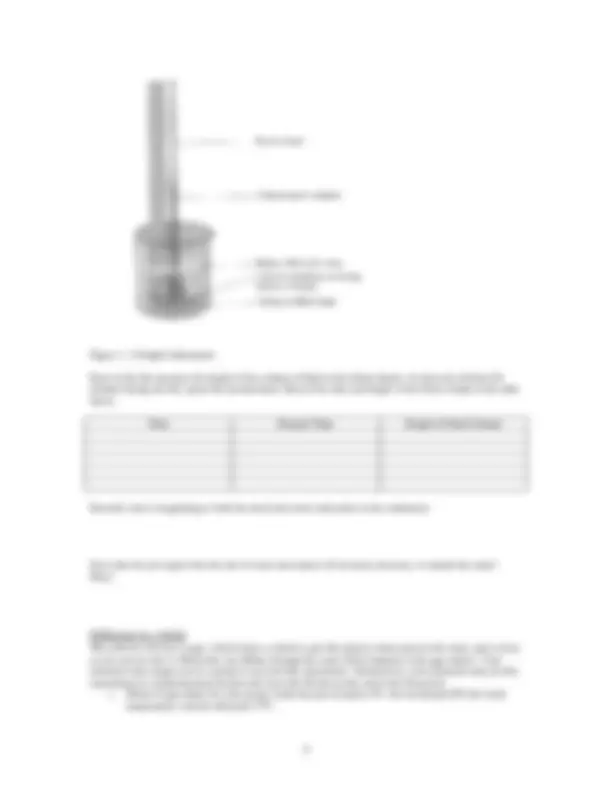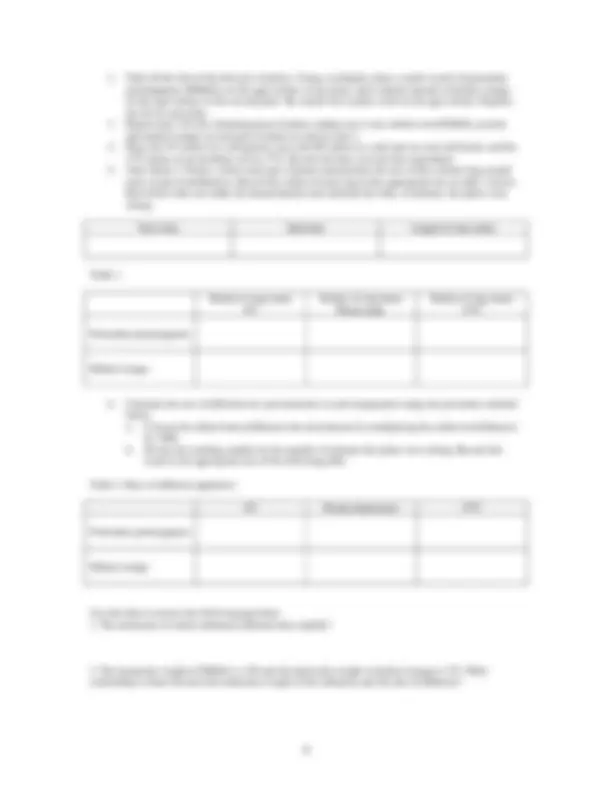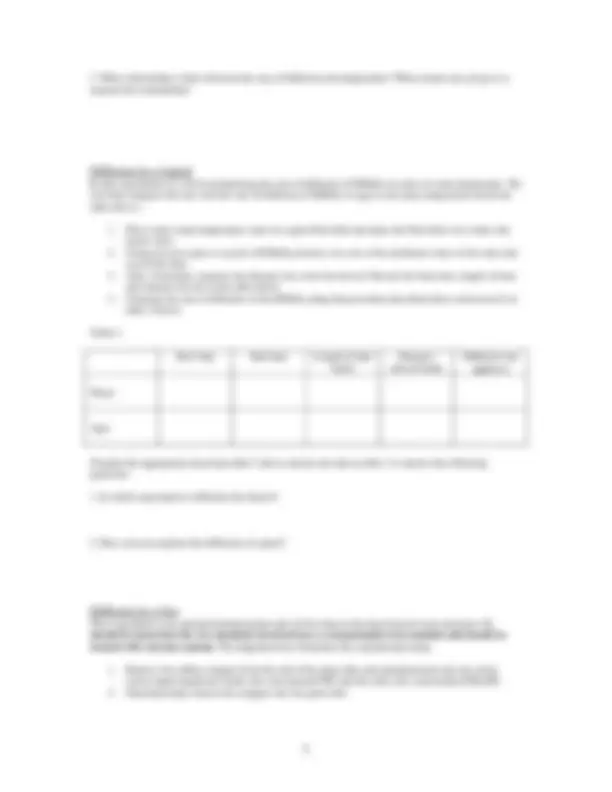





Study with the several resources on Docsity

Earn points by helping other students or get them with a premium plan


Prepare for your exams
Study with the several resources on Docsity

Earn points to download
Earn points by helping other students or get them with a premium plan
Community
Ask the community for help and clear up your study doubts
Discover the best universities in your country according to Docsity users
Free resources
Download our free guides on studying techniques, anxiety management strategies, and thesis advice from Docsity tutors
The concepts of solute, solvent, concentration gradient, osmotic pressure, and selectively permeable membranes. It also covers diffusion, osmosis, facilitated diffusion, and active transport processes. How temperature and molecular weight affect the rate of diffusion.
Typology: Lab Reports
1 / 6

This page cannot be seen from the preview
Don't miss anything!




Cells maintain a constant internal environment, a process called homeostasis. In a constant environment enzymes and other cellular components can operate at optimum efficiency. The ability to selectively exchange materials with the environment is one component of the cell’s homeostatic mechanism. Ions and molecules, such as sugars, amino acids and nucleotides, must enter the cell, and the waste products of cellular processes must leave the cell. Regardless of the direction of movement, the common mediator of these processes is the cell membrane, or plasma membrane.
The plasma membrane is a fluid, or mobile, mosaic of lipids and proteins. Ions and molecules cross the plasma membrane by a number of processes. Large particles are engulfed by the membrane, forming a vesicle or vacuole that can pass into (endocytosis) or out (exocytosis) of the cell. Some small, electrically neutral molecules diffuse through the spaces between the lipid molecules of the plasma membrane. Others bind to transport proteins embedded in the plasma membrane and transported into or out of the cell.
Atoms, ions and molecules in solution are in constant motion and continuously collide with each other because of their kinetic energy. As the temperature is raised, the speed of movement of the molecules increases and they collide more frequently and with greater force. An observable consequence of this motion is Brownian motion, an erratic, vibratory motion of small particles suspended in water, which is caused by the collisions of water molecules with the particles.
Diffusion also results from the kinetic energy of molecules. If a small crystal of a soluble substance is added to water, molecules of the substance break away from the crystal surface and enter solution. As a consequence of the collisions with water molecules, molecules of the substance move in a random pattern in the solution, but always away from the crystal, with some moving to the farthest reaches of the solution. This process continues until the molecules of the substance are evenly distributed throughout the water (the solvent). In a general sense, in any localized region of high concentration, the movement of molecules is, on average, away from the region of highest concentration and towards the region of lowest concentration. The gradual difference in concentration over the distance between the regions of high and low concentration is called the concentration gradient. The steeper the concentration gradient, the greater the rate of diffusion. The rate of diffusion is also directly proportional to the temperature and inversely proportional to the molecular weight of the diffusing molecules. In other words, the higher the temperature the faster the rate of diffusion, but larger molecules move slower than smaller molecules at the same temperature.
Small, electrically neutral substances diffuse into and out of cells by passing through the spaces between the lipids of the plasma membrane or by dissolving in the lipids or proteins of the membrane. Substances that are large or electrically charged cannot pass through membranes. Membranes that block or inhibit the movement of molecules are called differentially permeable, or selectively permeable. Selective permeability explains the phenomenon of osmosis, the diffusion of water across a membrane under certain conditions.
If two solutions containing different concentrations of a solute are separated by a selectively permeable membrane (permeable to water but not to the solute), water will move from the solution with low solute concentration to the solution of high solute concentration. The water flows in this direction because the solution with low solute concentration has a high water concentration and the solution with high solute
concentration has a low water concentration. Thus, the water diffuses from a region of high water concentration to a region of low water concentration.
Many ions and molecules important to cells are taken into cells by specific transport proteins found in cell membranes. Facilitated diffusion occurs when such a protein functions as a binding and entry port for the substrate. In essence, the protein functions as a pipeline for the specific substance. The direction of flow is always from high concentration to low concentration. The gradients are maintained because frequently the molecules are metabolically converted to other types of molecules once they enter the cell.
For many other molecules and ions, favorable diffusion gradients do not exist. For example, sodium ions are present at higher concentrations outside mammalian cells than inside the cells, yet the net movement of sodium ions is from the inside to the outside of the cell. Likewise, potassium ions are found inside mammalian cells at significantly higher concentrations than outside the cell, but the net movement of potassium ions is from the outside to the inside of the cell. For such molecules and ions, cellular energy must be used to transport the molecules across the plasma membrane. Active transport occurs when transport proteins in the cell membrane bind with the substrate and use cellular energy to drive the “pumping” of the molecules into or out of the cell, against the concentration gradient.
In today’s lab you will observe Brownian motion, osmosis, and diffusion in the solid, liquid and gaseous state, and investigate the parameters that affect the rate of diffusion of molecules. In next week’s lab, which is a continuation of your investigation of diffusion and the properties of cell membranes, you will model a semi-permeable membrane and investigate the behavior of different types of cells in hypotonic, hypertonic and isotonic solutions.
The vibratory movement exhibited by small particles in suspension in a fluid was first observed by the Scottish botanist Robert Brown in 1827. Brown incorrectly concluded that living activity was the cause of this movement, but we now know that Brownian movement results from the collisions between water molecules and small particles (less than 10 micrometers in diameter) suspended in the water.
To illustrate Brownian movement, place a drop of water on a microscope slide. Dip a dissecting needle into India ink and then touch the tip of the needle into the water drop. (India ink consists of small particles of carbon suspended in a fluid.) Add a coverslip and observe the slide with a high-power objective.
Briefly record your impressions of the movement of the particles. If you gently warm the slide over a light bulb, what effect does this have on the movement of the particles? How do you account for any changes in motion you observe after heating the slide?
The rate of water movement in osmosis can be observed with an osmometer (see figure below). A starch solution in the thistle funnel is separated from the water in the beaker by a dialysis membrane that allows water to pass through but is impermeable to starch. (The starch solution has had food coloring added to it so that you can track any movement of the solution in the thistle funnel.) What do you expect will happen over time in this type of setup?
Start time End time Length of time (min)
Table 1.
Radius of ring (mm) 4 oC
Radius of ring (mm) Room temp.
Radius of ring (mm) 37 oC
Potassium permanganate
Methyl orange
Table 2. Rate of diffusion (μm/min.)
4 oC Room temperature 37 oC
Potassium permanganate
Methyl orange
Use this data to answer the following questions.
In this experiment we will be determining the rate of diffusion of KMnO 4 in water at room temperature. We will then compare this rate with the rate of diffusion of KMnO 4 in agar at the same temperature (from the table above).
Table 3.
Start time End time Length of time (min)
Distance moved (mm)
Diffusion rate (μm/sec)
Water
Agar
Transfer the appropriate data from table 2 above and use the data in table 3 to answer the following questions.
This experiment is an optional demonstration and will be done at the discretion of your instructor. It should be noted that the two chemicals involved have a real potential to be harmful and should be treated with extreme caution. The diagram below illustrates the experimental setup.